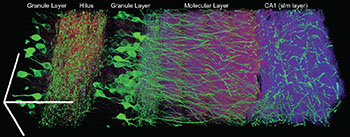Expansion microscopy rendering of 500 μm × 180 μm × 100 μm volume of mouse hippocampus, biochemically tagged to show neurons (green) and synapses (red and blue) [click to enlarge]. [Image: Chen et al., Science, doi: 10.1126/science.1260088]
All conventional optical microscopes run up against the diffraction limit, which prevents the microscope from resolving features smaller than half the wavelength of the incident light. Indeed, the development of super-resolution microscopy, a way around this fundamental barrier, captured last year’s Nobel Prize in chemistry. Now, scientists from the Massachusetts Institute of Technology (MIT), USA, have proposed an alternative way to beat the diffraction limit for some biological samples: inflating the specimen until the relevant fine features can be optically resolved (Science, doi: 10.1126/science.1260088). Dubbed “expansion microscopy,” the technique can, according to the team, “be used to perform scalable super-resolution microscopy with diffraction-limited microscopes.”
To achieve this slight-of-hand in fragile biological specimens, the MIT scientists relied on a polyelectrolyte gel that could be chemically triggered to swell up to some four times its original volume. They infused the gel into cultured human embryonic kidney cells and mouse brain specimens, and found that when they flipped the chemical switch, the specimens expanded almost isotropically, with no appreciable distortion.
The group then designed a “custom fluorescent label” that could covalently bond at close spacing to the polymer within the specimen, yet could also be tweaked to target specific biomolecules. When the specimens so labeled were “blown up” to around four times the original size using the bonded expanding gel, the researchers could resolve fine features such as cell microtubules and neuronal synapses, with a resolution of up to 70 nm and with greater sharpness than achieved in ordinary super-resolution microscopy.
Additional explorations by the team established that expansion microscopy could work at multiple length scales within a single sample with fast diffraction-limited microscopes. That, in turn, suggests that the technique can “support scalable super-resolution microscopy” using conventional diffraction-limited scopes, according to the researchers. And, they argue, the approach could extend some other fast, cutting-edge techniques, such as light-sheet microscopy, into the super-resolution realm.


